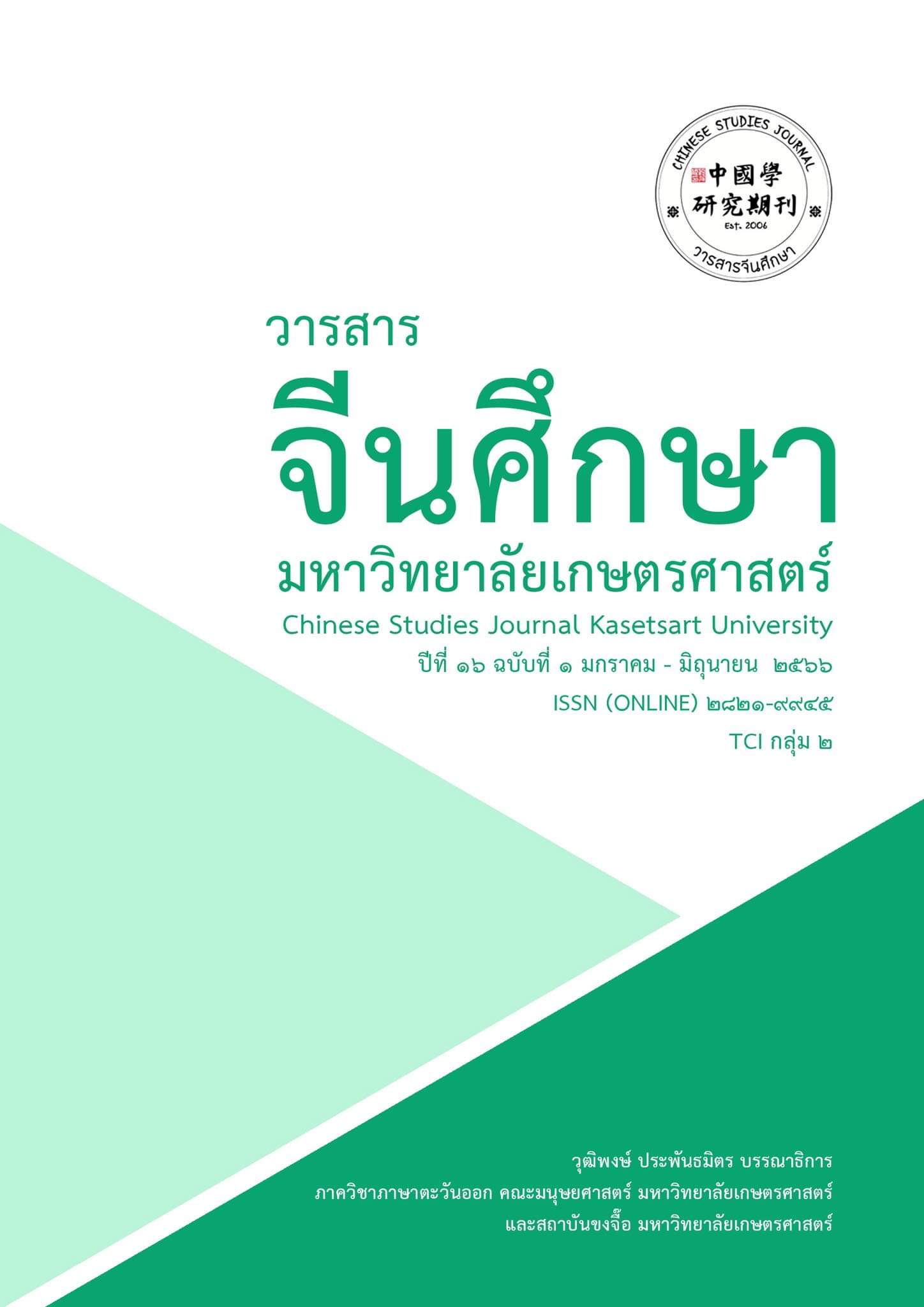A Comparative Study of Folk Tales in Teaching Chinese as a Foreign Language-- Take The Cowherd and the Weaver Girl and Jaka Tarub as examples การวิจัยศึกษาเปรียบเทียบนิทานพื้นบ้านในการสอนภาษาจีนในฐานะภาษาต่างประเทศ: การศึกษาเปรียบเทียบนิทานพื้นบ้านเรื่อง “หนุ่มเลี้ยงวัวกับสาวทอผ้า” และ “Jaka Tarub”
Main Article Content
Abstract
Folk tales with the characteristics of simple and colloquial language expression have been gradually introduced into teaching Chinese as a foreign language classes, however in many cases, the teaching methods adopted by teachers do not pay attention to the acceptance of students and directly bring the Chinese folk tales into teaching activities. Based on the author's learning experience, this paper will try to compare the two folk stories about the love between "God and human" in China's The Cowherd and The Weaver Girl and Indonesia's Jaka Tarub stories, and try to find out the same and different cultural concepts and thinking patterns between Chinese and Indonesians. Furthermore, it is found that the comparison between different countries' folk tales is helpful to improve the cross-cultural communication ability of teachers and students, become the new learning entertainment for the cultural teaching curriculum, and has the significance of consolidating students' mastery of language knowledge. But at the same time, students' learning needs, teachers' understanding of students' culture background and the rationality of curriculum arrangement should also be considered, so as to comprehensively improve the quality of teaching Chinese culture as a foreign language.
Article Details

This work is licensed under a Creative Commons Attribution-NonCommercial-NoDerivatives 4.0 International License.
ผลงานทางวิชาการที่ลงตีพิมพ์ในวารสารจีนศึกษา มหาวิทยาลัยเกษตรศาสตร์ เป็นลิขสิทธิ์ของผู้เขียนหรือผู้แปลผลงานนั้น หากนำลงในวารสารจีนศึกษาเป็นครั้งแรก เจ้าของผลงานสามารถนำไปตีพิมพ์ซ้ำในวารสารหรือหนังสืออื่นได้โดยมิต้องแจ้งให้ทราบล่วงหน้า แต่หากผลงานที่ได้รับพิจารณานำลงในวารสารจีนศึกษา เป็นผลงานที่เคยตีพิมพ์ที่อื่นมาก่อนเจ้าของผลงานต้องจัดการเรื่องปัญหาลิขสิทธิ์กับแหล่งพิมพ์แรกเอง หากเกิดปัญหาทางกฎหมาย ถือว่าไม่อยู่ในความรับผิดชอบของวารสารจีนศึกษา มหาวิทยาลัยเกษตรศาสตร์ ทั้งนี้ ความคิดเห็นต่างๆ ในบทความเป็นความคิดเห็นส่วนตัวของผู้เขียน ไม่เกี่ยวกับกองบรรณาธิการวารสารจีนศึกษา มหาวิทยาลัยเกษตรศาสตร์
References
丁乃通. 中国民间故事类型索引.武汉:华中师范大学出版社,2008.
段宝林. 中国民间文学概要.北京:北京大学出版社,2018.
黄涛. 中国民间文学概论.北京:中国人民大学出版社,2013.
Inni Inayati Istiana, Pardi, Mochammad Fikri, Tri Wahyuni, Karyono. Legenda Jaka Tarub Dalam Perbandingan[M]. Semarang: Balai Bahasa Provinsi Jawa Tengah Badan Pengembangan dan Pembinaan Bahasa Kementerian Pendidikan dan Kebudayaan,2015.
李建树,孙侃. 中国民间故事.杭州:浙江少年儿童出版社,2009.
李晓琪. 对外汉语文化教学研究.北京:商务印书馆,2006.
梁立基. 印度尼西亚文学史.北京:昆仑出版社,2003.
刘珣. 对外汉语教育学引论.北京:北京语言大学出版社,2000.
祁连休. 中国古代民间故事类型研究.石家庄:河北教育出版社,2007.
斯蒂•汤普森. 世界民间故事分类学.上海:上海文艺出版社,1991.
万建中. 新编民间文学概论.上海:上海文艺出版社,2011.
许友年译. 印度尼西亚民间故事.北京:中国民间文艺出版社,1983.
姚斯、霍拉勃. 接受美学与接受理论.沈阳:辽宁人民出版社,1987.
袁珂. 中国民间故事.成都:四川少年儿童出版社,1987.
张岱年,方克立. 中国文化概论. 北京:北京师范大学出版社,2004.
祖晓梅. 跨文化交际.北京:外语教学与研究出版社,2015.
古大勇,李聪泳. 2014. 印尼与中国民间故事比较研究. 怀化学院学报,33(04):9-12.
Krisna Wahyuningtyas, Ahmad Pramudiyanto. Perbandingan Motif Cerita Jaka Tarub dan Nawang Wulan dengan Cerita Niulang Zhinü. Jurnal Diwangkara,2021,(01):16-25.
李少杰,王海华. 中西方神话对比研究. 晋城职业技术学院学报,2018,11(02):85-87+96.
刘青梅. 文化哲学视野中的中、日神话之比较. 日本研究,2003,(02):78-84.
隆滟. 民族民间文学的传承与变异——布依族《重然的故事》与汉族《牛郎织女》之比较.
兰州文理学院学报(社会科学版),2017,33(06):74-79.
隆滟.牛郎织女传说情节的丰富变异性——《天牛郎配夫妻》与南方少数民族有关传说的比较. 西北民族研究,2008,(02):126-130+185.
隆滟. 七夕节俗的农耕文化透视. 中国农史,2011,30(04):107-113.
孟昭毅. 中越神话传说比较谈. 解放军外语学院学报,1994,(02):94-99+108.
齐海英,邱思文. 汉语国际推广语境中的中国民间故事. 沈阳大学学报(社会科学版),2016,18(05):606-610.
邱思文,齐海英. 2016. 满、蒙民间故事在东北地区对外汉语教学中的应用[J]. 新丝路(下旬),(06):109.
Ratu Wardarita,Guruh Puspo Negoro. A Comparative Study: The Folktale of Jaka Tarub (Indonesia) and Tanabata (Japan)[J]. Advances in Language and Literary Studies,2017,8(6):1-6.
钟进文. 裕固族与匈牙利民间故事比较研究[J]. 民族文学研究,1992,(04):61-65.
蔡堂根. 中国文化中的人神恋. 浙江大学,2004.
陈鹏程. 先秦与古希腊神话价值观比较研究.天津师范大学,2006.
CLEMENT TANAKA 陈衍宏. 中国民间故事在对外汉语教学中的接受研究——以重庆大学印尼留学生对《牛郎织女》接受程度为例.重庆大学,2021.
胡占斌. 汉语国际推广中民间故事传说类文化内容之教学研究. 广州:暨南大学,2013.
李颖超. 中国民间传说在对外汉语教学中的应用研究. 兰州:兰州大学,2019.
施美娇. 泰国清迈泰族《金海螺》与西双版纳傣族《蝉面人》故事对比研究.云南民族大学,2013.
孙莹莹. 民间故事在对外汉语教学中的研究. 开封:河南大学,2014.
Visunce Fransisca(冯慧珊). 来华印尼留学生汉语文化词使用研究.华南理工大学,2016.
赵宁晗. 印度尼西亚《桑古里昂》故事异文对比研究.云南民族大学,2019.
郑丹丹. 俄汉民间故事中的家庭观念对比研究.哈尔滨理工大学,2015.
韩琪,徐佩. 俄中民间故事中善的观念对比研究. 教育部基础教育课程改革研究中心.2020年“区域优质教育资源的整合研究”研讨会论文集.教育部基础教育课 程改革研究中心:教育部基础教育课程改革研究中心,2020:4.


